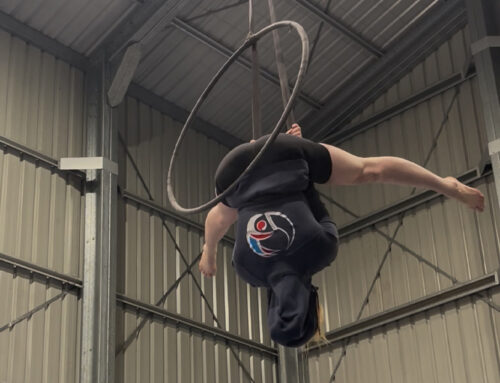Hi, it’s Sonia and Amanda here and we would like to talk to you about aerial hoops. Buying an aerial ring, especially for the first time, can be an overwhelming experience. Solid or hollow? Single point or tabless? What size? Which tape to buy? Do I need powder coating? What accessories do I need? And who do I buy from? So many questions! And we hear them on pretty much daily basis, often from parents or aerialists’ partners who want to purchase an aerial ring for a loved one but have no idea where to start. We are here to answer your questions and guide you through your journey of purchasing a lyra.
This blog is going to tackle the first dilemma, which often seems to be the biggest one: solid vs hollow lyra.
Strength
All of our aerial hoop products are manufactured to meet Live Performance Australia Guidelines. We offer two different types of hoops: engineer certified (to AS/NZS 1554.6) and NATA destruction tested only. You can read more about the difference between the hoops here.
The discussion of certification and different ratings is a very long and complicated one, but for the purpose of this article, we are going to approach it from the simplest angle. (If you would like to find out more about the equipment, their ratings and/or certification, please see the above blog and our product information sheets for each product). The strongest of our lyras are the solid lyras. They have the highest Minimum Breaking Strain (MBS). If you are planning to use your lyra for dynamic work, duos or trios, we recommend purchasing a solid hoop.
Weight
The solid lyra is heavier than a hollow lyra. This difference is quite considerable. On average our solid lyras weigh 9.5kg while hollow lyras are only 3.5kg. Weight will most definitely be a factor in your decision if you plan to travel doing aerial performing or training. Carrying an almost 10kg hoop as opposed to a less than 4kg hoop makes a massive difference. Not to mention excess baggage costs for air travel!
That said, if you are going to be using your lyra at home or at your local studio, a solid ring might be a better option. The additional 6kg of weight, makes the solid hoop a far more stable apparatus. Now more than ever, this is an important factor, as we see hoop work shifting away from flexible poses and towards more consistent dynamic work: spinning, swinging, dropping, releasing and re-catching tricks are becoming standard lyra skills. A solid ring will stay ‘underneath’ you, while a hollow ring may ‘fling away’ as you are trying to re-catch it in mid-air. A hollow ring will definitely make these tricks harder and potentially less safe as well.
Comfort
I won’t lie to you! Solid aerial hoops hurt. Don’t get me wrong, hollow hoops hurt too but the hollow hoop is slightly thicker so it is the more comfortable of the two “torture devices”! Our solid rings are made from 22mm solid stainless bar, while hollow rings are made from, you guessed it, a hollow tube that is 25mm in diameter. And yes, those 3mm make all the difference…
Many aerialists tend to buy the same type of ring that is being used at their studio. And that makes sense, because that’s what you’re used to. Talking with your coach or your studio owner is definitely a good place to start making your decisions.
I will just say one more thing – if you start on a hollow ring and down the road you find you need the stability of a solid one, it is not fun adjusting to that next level of pain. When you begin to transition over, it’s going to feel like your first lesson all over again! And ohhhh, we all remember THAT pain! So, starting on a solid lyra might be the best way to go, get all the pain out of the way in one go so when you advance to dynamic skills, you have nothing holding you back!
Spinning
What’s a lyra routine without a spin? If you love to spin then that’s another reason to go with a solid ring. A solid ring will spin faster and considerably longer than a hollow ring. But if spinning makes you feel green, then maybe the hollow hoop will be your new best friend because the spin is slower and doesn’t last as long.
Age of aerialist
This is definitely something to consider when choosing the right lyra. While we sell both solid and hollow lyras in a variety of sizes for both adults and children, many kids might not love the amount of pain that comes with circus training. Being up in the air can be scary enough, let alone painful. If that’s the case, a hollow ring might make your little one’s circus training a bit more enjoyable.
Price
There is also a price difference between the two types of lyra. The hollow ring is a little cheaper. So if finances are a concern for you or if you want to use part of your circus budget on some of our awesome lyra accessories, our hollow ring might be the best choice for you. On the other hand, price should never, in our opinion, be your main deciding factor when it comes to circus safety. Choose the ring that best suits your needs now and in the future. After all, there’s always Afterpay… 🙂
We hope this helps answer some of your questions and we’ll be back soon with more info on lyras and our other awesome aerial gear.








